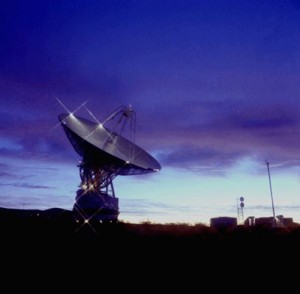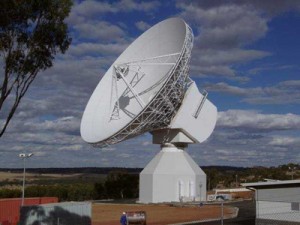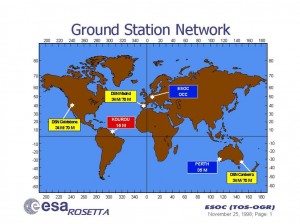The Ground Stations

Source: NASA
The scientific data and commands for telecommunication of the spacecrafts are received by the NASA antenna complexes of the Deep Space Network (DSN) and the new antennae of ESA in Perth (Australia) and Cebreros (Spain) in order to get processed further.
Interplanetary spacecrafts often depart several hundred million kilometers from Earth on their often quite complicated flight path. Additionally the size of a spacecraft is pretty limited due to technical and financial reasons. So the sending and receiving facilities on board can only send signals with little power towards the Earth. Therefore the effort to receive a good signal on Earth is the more. To filter the weak signal out of the general cosmic noise the ground stations are equipped with large satellite dishes. Particular low-noise receiving systems amplify the signal and change it to another carrier frequency for further processing. To smother the ground noise, the receiving systems are cooled down to 30 K which corresponds to -243 °C.
Damit Daten auch über längere Zeit gesendet und empfangen werden können, ist bei der Bewegung der Antenne besonders hohe Präzision gefragt. Der Fehler bei der Nachführung der Antenne, der sogenannte „Tracking Error“, darf in Abhängigkeit von der Sendefrequenz nur wenige Tausendstel bis Hundertstel Grad betragen.
The members of the ground stations are the new antennae of ESA in Perth (Australia, 35 m) and Cebreros (Spain, 35 m) and the Deep Space Network (DSN) of NASA (34 m and 70 m) with antennae complexes in California, Spain and Australia. When the spacecrafts are visible for the ground stations and the high gain antenna (HGA) of the spacecraft looks towards the Earth, the distance and the Doppler shift of the carrier frequency can be determined and hence the radial velocity of the spacecrafts.
In the two-way-mode the ground station transfers an uplink signal in the X-band an simultaneously receives radio signals in the X-band and S-band. The information gained from the measurements are amplitude, frequency and polarization of the radio signal which in the end get saved as functions of the local time of the ground station.

Source: ESA
Approx one and a half hour’s drive north of Perth lies New Norcia on the west coast of Australia. There the ESA installed her new 35-m ground station in 2002. The operable antenna installation is controlled by the European Space Operation Centre ESOC in Darmstadt. The ESOC is responsible for all scientific missions of ESA. Therefore it has a network of various ground stations available in the whole world.

Die amerikanische Raumfahrtbehörde NASA unterhält bereits seit Beginn der Raumfahrt ein weltweites Kommunikationsnetzwerk, um mit ihren Raumsonden jenseits des Erde-Mond-Systems Kontakt zu halten. Das Deep Space Network (DSN) besteht aus drei Komplexen in Goldstone (Kalifornien), bei Madrid (Spanien) und bei Canberra (Australien). Diese sind so angeordnet, dass sie jeweils etwa 120 Längengrade voneinander entfernt sind, wodurch die NASA trotz der Erdrotation permanent Kontakt zu jeder beliebigen Raumsonde halten kann. Dazu wird die Kommunikation im Tagesverlauf von Station zu Station „weitergegeben“. Die gigantischen 70 m-Antennen des DSN werden im übrigen nicht nur zur Kommunikation mit Raumsonden wie Pioneer und Voyager, die sich schon weiter als Pluto von der Sonne entfernt haben, sondern auch für radioastronomische Forschungsvorhaben wie z.B. Asteroidenradar genutzt.